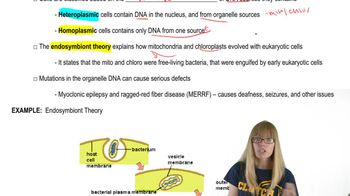Table of contents
- 1. Introduction to Genetics51m
- 2. Mendel's Laws of Inheritance3h 37m
- 3. Extensions to Mendelian Inheritance2h 41m
- 4. Genetic Mapping and Linkage2h 28m
- 5. Genetics of Bacteria and Viruses1h 21m
- 6. Chromosomal Variation1h 48m
- 7. DNA and Chromosome Structure56m
- 8. DNA Replication1h 10m
- 9. Mitosis and Meiosis1h 34m
- 10. Transcription1h 0m
- 11. Translation58m
- 12. Gene Regulation in Prokaryotes1h 19m
- 13. Gene Regulation in Eukaryotes44m
- 14. Genetic Control of Development44m
- 15. Genomes and Genomics1h 50m
- 16. Transposable Elements47m
- 17. Mutation, Repair, and Recombination1h 6m
- 18. Molecular Genetic Tools19m
- 19. Cancer Genetics29m
- 20. Quantitative Genetics1h 26m
- 21. Population Genetics50m
- 22. Evolutionary Genetics29m
3. Extensions to Mendelian Inheritance
Organelle DNA
Problem 20c
Textbook Question
Payne, B. A. et al. (2013) present evidence that a low level of heteroplasmic mtDNA exists in all tested healthy individuals.
What genetic conditions within a given mitochondrion are likely to contribute to such a variable pool of mitochondria?
 Verified step by step guidance
Verified step by step guidance1
Understand that heteroplasmy refers to the presence of more than one type of mitochondrial DNA (mtDNA) within a cell or individual.
Recognize that mutations in mtDNA can lead to heteroplasmy, as mitochondria have their own DNA separate from nuclear DNA.
Consider that during cell division, mitochondria are distributed randomly to daughter cells, which can lead to varying levels of mutated mtDNA in different cells.
Acknowledge that the bottleneck effect during oogenesis (egg cell formation) can result in a wide range of mtDNA variants being passed to offspring.
Realize that selective replication of certain mtDNA types within cells can also contribute to the variability in the mitochondrial pool.
Recommended similar problem, with video answer:
 Verified Solution
Verified SolutionThis video solution was recommended by our tutors as helpful for the problem above
Video duration:
2mPlay a video:
Was this helpful?
Key Concepts
Here are the essential concepts you must grasp in order to answer the question correctly.
Heteroplasmy
Heteroplasmy refers to the presence of more than one type of mitochondrial DNA (mtDNA) within a single cell or individual. This condition can arise from mutations in mtDNA, leading to a mixture of normal and mutated genomes. The level of heteroplasmy can vary among tissues and individuals, influencing mitochondrial function and potentially contributing to various genetic conditions.
Recommended video:
Guided course

Organelle DNA Characteristics
Mitochondrial Inheritance
Mitochondrial inheritance is a unique form of genetic transmission where mtDNA is passed down maternally. Unlike nuclear DNA, which is inherited from both parents, mtDNA is inherited exclusively from the mother. This mode of inheritance can lead to the expression of mitochondrial diseases that may vary in severity based on the proportion of mutated mtDNA present in the offspring.
Recommended video:
Guided course

Organelle Inheritance
Mitochondrial Dynamics
Mitochondrial dynamics encompass the processes of mitochondrial fusion and fission, which are crucial for maintaining mitochondrial function and health. These processes allow mitochondria to adapt to cellular energy demands and stress. Variations in these dynamics can lead to a heterogeneous population of mitochondria within a cell, contributing to the observed heteroplasmy and influencing the overall health of the cell.
Recommended video:
Guided course

Organelle Inheritance

 4:11m
4:11mWatch next
Master Organelle DNA Characteristics with a bite sized video explanation from Kylia Goodner
Start learningRelated Videos
Related Practice

